
Editor’s note: This guest blog, written by Karlee Pringle, a student occupational therapist in the School of Occupational Therapy at the University of Western University in Ontario, Canada, discusses tools (assistive devices) to help people with Parkinson’s more safely and easily complete bathroom-related activities.
How can assistive devices help individuals with Parkinson’s disease with bathroom-related activities?
There are various assistive devices that have been developed to support individuals in completing bathing and grooming tasks in an easier and more effective way. Individuals with Parkinson’s can experience a range of symptoms across the stages of Parkinson’s disease that may make bathroom-related activities more challenging. The following article is presented to increase awareness of devices that you may use now or in the future to prevent the potential of falls and injuries. Especially for individuals experiencing fatigue or changes to balance, it is important to know how to use strategies to navigate the bathroom where slippery surfaces can occur. It is important to note that all the assistive devices may not be required for a single individual with Parkinson's, but each may be helpful to know about. If you are feeling concerned about your safety due to symptoms of Parkinson’s, it’s best to reach out to an occupational therapist who is well-informed on the proper use and installation of these devices.
Non-slip bathmat
A non-slip bathmat is highly recommended for inside and outside the shower. The mat inside the shower should have a suction-cup bottom that grips the shower or tub floor to prevent falls. A mat outside the shower/tub is also recommended to prevent water from getting on the floor and creating a fall risk. Bathmats with rubber bottoms that grip the floor are best, however, double-sided tape or rubber mats can be purchased separately and placed under the existing bathmat.
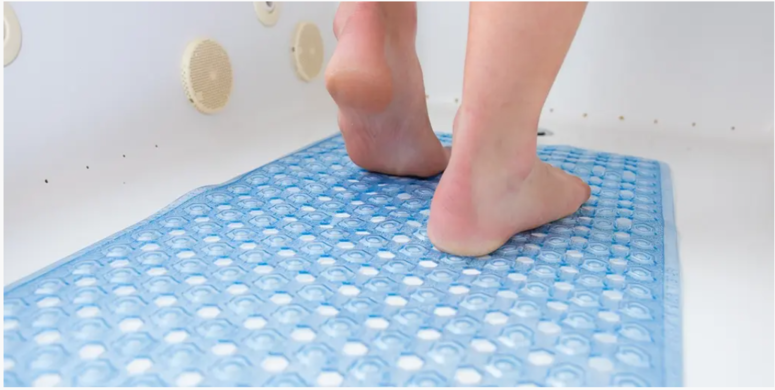
Grab bar
Installing permanent grab bars in the bathroom and shower is a great idea to increase support and prevent falls. However, if you rent, seeking permission from your landlord or building owner may be required. It is important to note which bars currently exist in your bathroom and what they are actually designed for. You should never use a towel bar or soap holder to support your weight. Instead, grab bars properly installed into the wall are designed to support your weight as you enter and exit the shower. Since the layout of each individual bathroom is a bit different, reaching out to an occupational therapist can be helpful when determining the length, type, and placement of a specific grab bar.

Clamp-on grab bar
If you are unable to install grab bars directly on the walls of your shower, an alternative option is a removable clamp-on grab bar. This device is a water-resistant handlebar designed with an adjustable width clamp that will fit over the tub and can be secured in place by tightening the clamp and adjusting the handle to the preferred height. When entering and exiting the tub, you can hang on to the handle with one or both hands to safely step in or out.
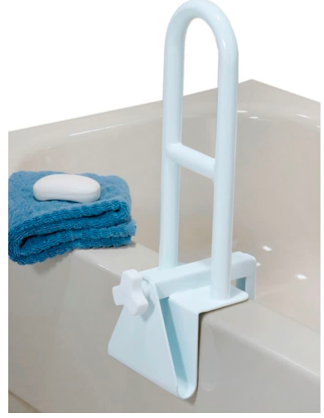
Shower chair
For individuals experiencing fatigue or changes to their balance, a shower chair can be useful. A shower chair is a water-safe removable chair with a plastic seat, aluminum legs and rubber feet that can be used to sit on while showering. Most shower chairs come with backrests, handles on each side, adjustable seat heights and suction cup feet that grip the shower floor to prevent the chair from moving or tipping. If you find it challenging to stand for prolonged periods of time while showering due to fatigue, low blood pressure or neuropathy (sensitivity, numbness or weakness in the feet), this is a great non-permanent device to put in your bathroom. Please note, it is important for either you or a care partner to always ensure the feet of the chair are properly suctioned before every shower.
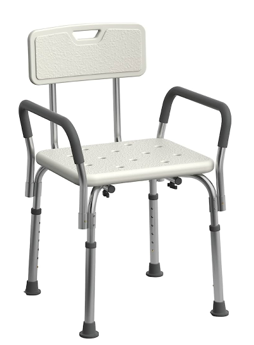
Removable showerhead
If purchasing a shower chair, it is helpful to additionally acquire a removable shower head. This will allow you to bring the showerhead down and more easily reach all areas of your body. This item can be especially useful for care partners when helping with bathing tasks. Suction cup shower head holders can also be purchased which attach to the shower wall through suction and hold the showerhead in place so you can be hands-free when completing bathing tasks. Since this item uses suction rather than direct installation into the wall, it is important to regularly check that it is properly suctioned to the wall before beginning bathing.
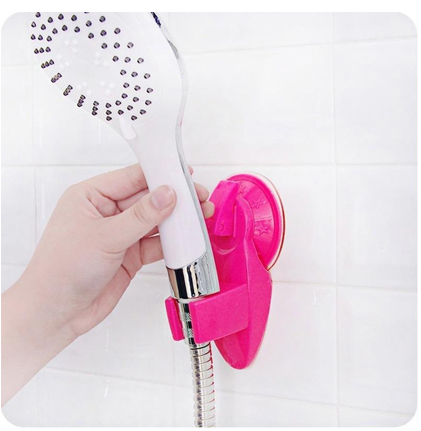
Toilet frame
For some people, sitting down and standing up, especially from the toilet, can be difficult. While grab bars (just as in the shower) can be helpful, not all individuals are able or allowed to install bars in their bathrooms. Toilet frames are a good alternative option. These devices
attach to the back of the toilet underneath the seat, allowing for easy installation. The device comes with rubber handles for grip and rubber feet that prevent the device from moving. When getting on or off the toilet, you can use the handles to support you.
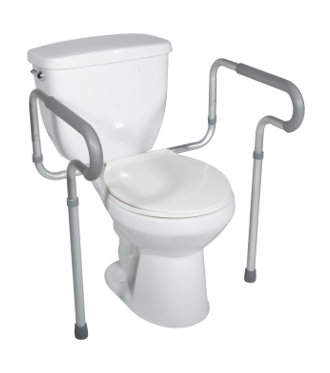
Raised toilet seat
If the height of your toilet seat is causing difficulty for transferring on and off the toilet, a raised toilet seat could be helpful. Raised toilet seats attach to the toilet bowl through a clamp that is tightened at the front of the seat. When installed, the existing seat will be removed and will be replaced with the raised device. Raised toilet seats can be purchased at different heights and can come with or without handles based on what best meets your needs.
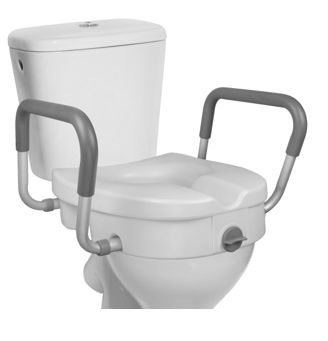
Foam grips for grooming items
For individuals experiencing difficulty grasping grooming tools such as toothbrushes, hairbrushes, razors, etc., foam tubing grips can help increase the size of the item, making it easier to grip. The foam tubes come in various different sizes with bigger holes to fit the item you need or with increased width depending on your needs.
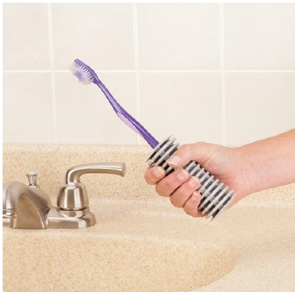
How can you find these devices?
The devices discussed above can be found and purchased in online retail stores as well as medical supply stores. When selecting an assistive device, there are many different considerations, such as cost, availability and general satisfaction when using the device. It is highly recommended that you reach out to an occupational therapist who can assess your current abilities, match you with the best device and teach you how to use it properly.
To learn more about occupational therapy and find a therapist in your area, read MJFF’s blog.
References
- Bathmat [Online image]. (2018). The New York Times. https://www.nytimes.com/wirecutter/reviews/best-shower-mat/
- Clamp-on Grab Bar [Online image]. (n.d.). Activaide Medical Equipment.https://www.activaide.ca/clamp-on-tub-rail.html
- Raised Toilet Seat [Online image]. (n.d.). Amazon. https://www.amazon.ca/RMS-Raised-Toilet-Seat-Adjustable/dp/B0889KQVPW
- Shower Chair [Online image]. (n.d.). Amazon. https://www.amazon.ca/Medline-MDS89745RA-Shower-Padded-Armrests/dp/B01MSISJKG
- Shower Grab Bar [Online image]. (2020). Buy Railings. https://www.buyrailings.com/blog/post/shower-grab-bar-installation-guide
- Shower Head Holder [Online image]. (n.d.). Joom. https://www.joom.com/en/products/1509432120272062806-67-1-26193-3617848811
- Toilet Safety Frame [Online image]. (n.d.). Shop Parker.https://shopparker.ca/toilet-safety-frame-versa-frame/